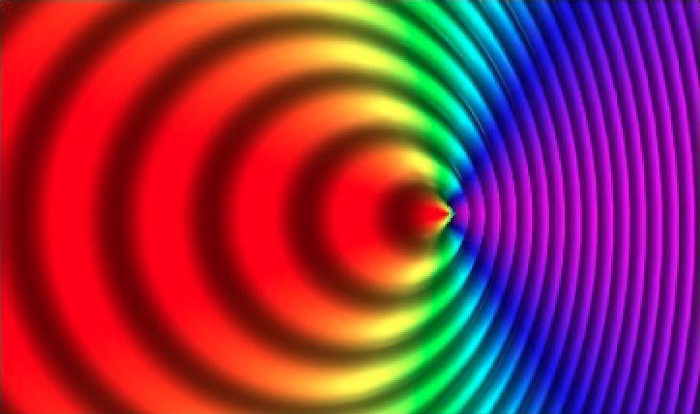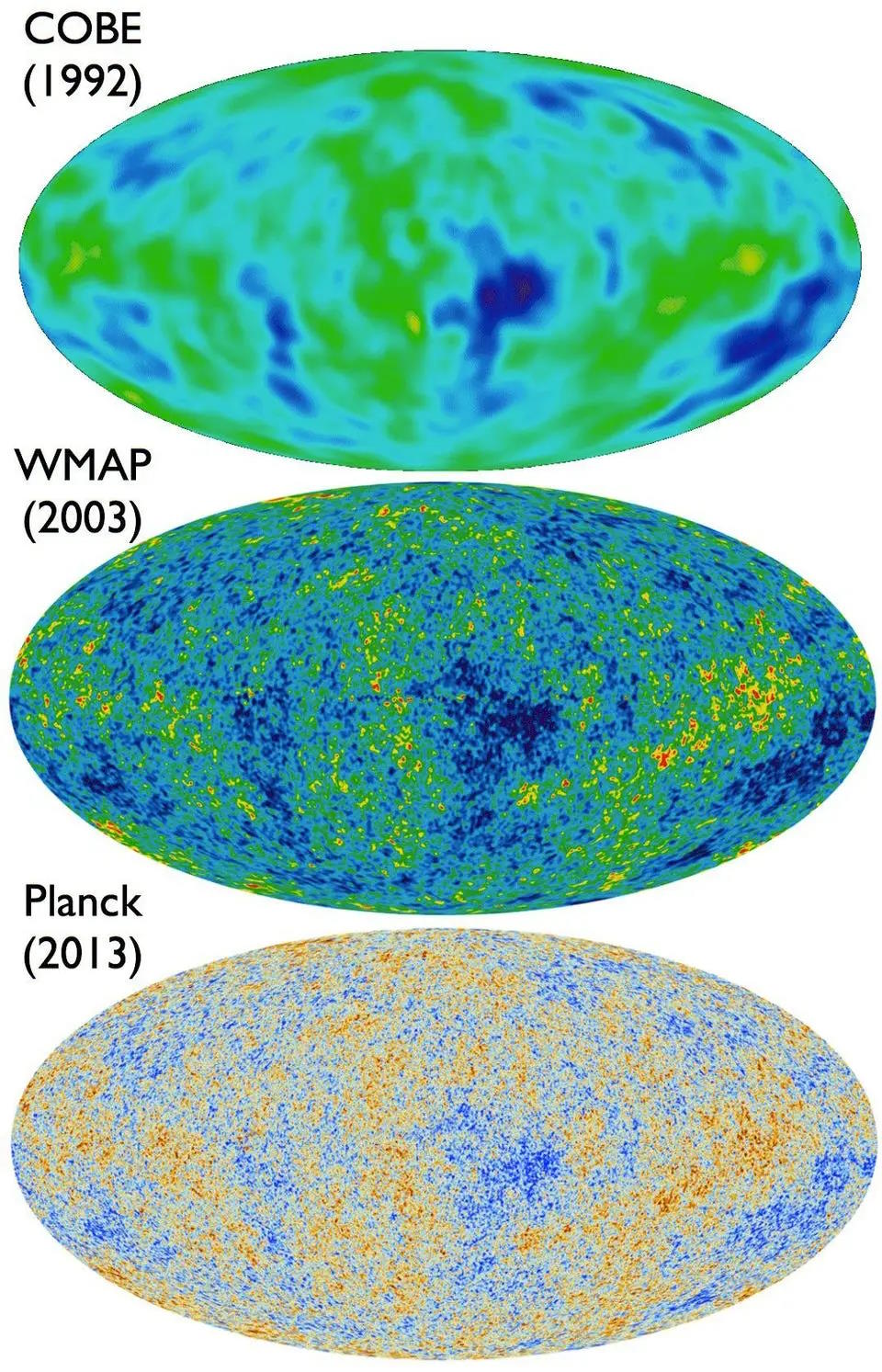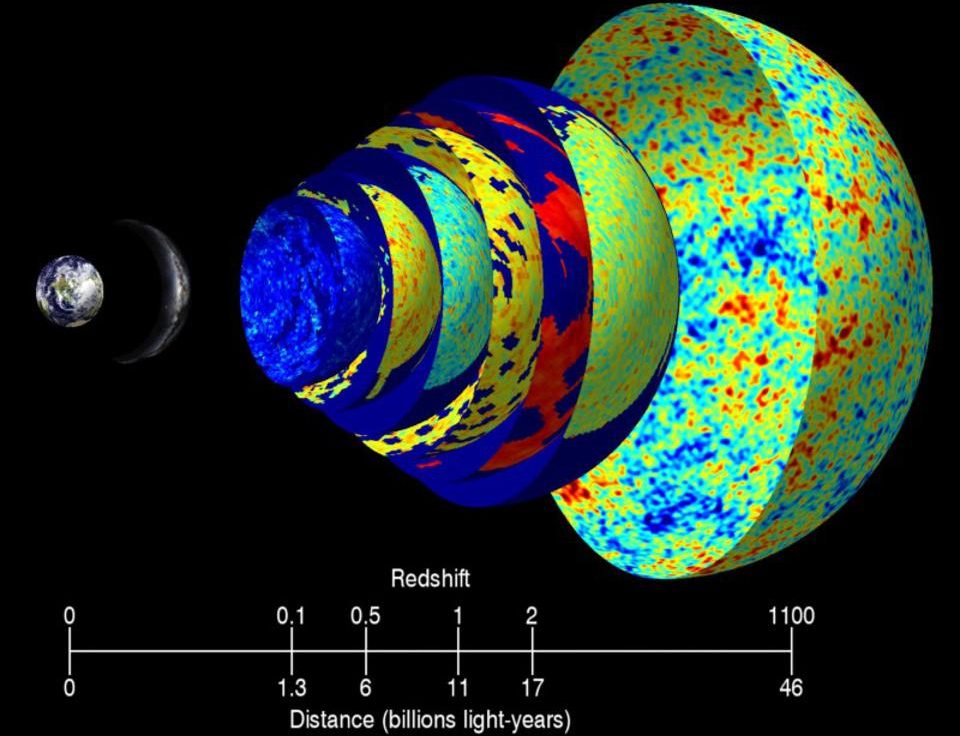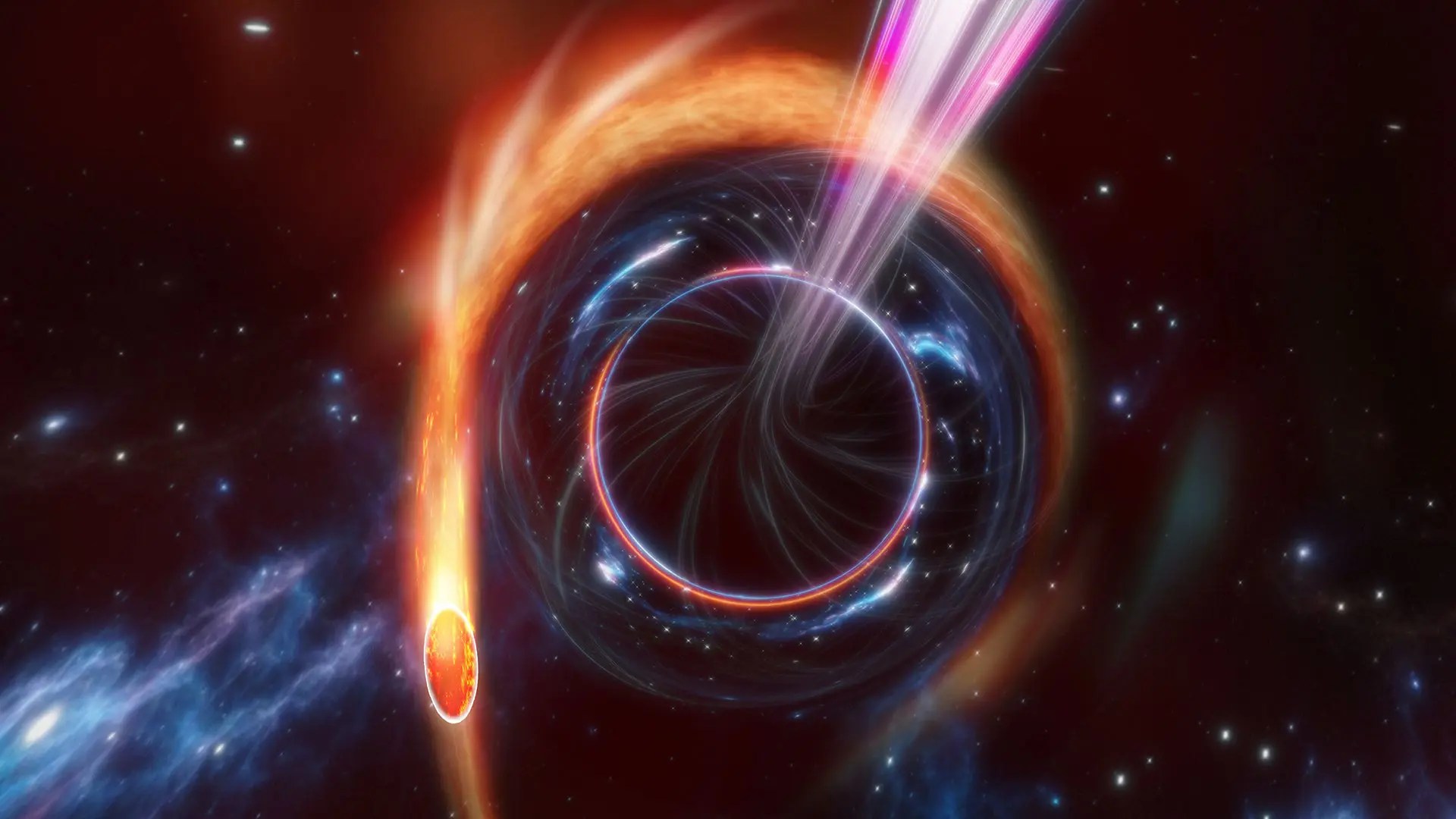How far away are we from the location of the Big Bang?

- If you measure the redshift and blueshift of every galaxy, you can trace it back to a point, and that point isn’t centered on us.
- It’s tempting to ask the question, “Where is that point?” And the answer is it’s relatively close by: several million light-years away, but that’s less than 0.1% the size of the visible Universe.
- But that’s not the right way to think about the Big Bang, which is better thought of as a moment in time, not a location in space. Here’s why.
One of the most difficult concepts for anyone — even a professional astrophysicist — to wrap their minds around is the idea of the Big Bang and the expanding Universe. Off in the far-flung distance, at the limit of what even our most powerful telescopes can see, are galaxies speeding away from us so quickly that the light their stars emitted has been stretched to as much as twelve times their original wavelength. These stretched light waves are a consequence of the expanding Universe, and they are nearly, but not quite, identical for galaxies that we see in all directions in space.
Does that difference, and the fact that one direction has a slightly greater redshift for its objects than the opposite direction, tell us anything about where, all those billions of years ago, the Big Bang actually occurred? After all, we can use redshift to determine when light is receding from us and blueshift to determine when light is heading toward us, and so, if the light left over from the Big Bang is preferentially redshifted in one direction and blueshifted in the opposite direction, can that tell us something about where we are relative to the “origin point” of the Big Bang?
This isn’t something we normally do in astrophysics, and for good reasons, but we could. Let’s take a look at what we learn if we do this first, and then let’s explore why we don’t.

When we look out at the Universe, what we see is that there’s a spectacularly consistent relationship between the light we measure from galaxies and how far away we measure those galaxies to be. On average, as confirmed for thousands upon thousands of galaxies at all different distances, the farther away a galaxy is from us, the greater the amount its light is redshifted. We not only see this relationship in all directions, but it’s remarkably simple: the speed that we infer these galaxies to be moving at is directly proportional to their measured distance from us.
This was the key observation, first made way back in the 1920s, that led cosmologists to conclude that the Universe was expanding. The farther away an object is, the faster we see it receding from us: a rule that holds as far as we’ve been able to look for nearly a full century now. When we look out at a very granular level, however, we see there are very, very slight directional differences: in one direction, things are just very slightly redshifted a little bit more than average, while in the opposite direction, things are just very slightly blueshifted a little bit more than the average.

In a way, though, this makes sense. Consider that the Universe isn’t perfectly uniform, but rather that there are gravitational imperfections in it:
- regions of space that have more matter in them than average, like stars, galaxies, and groups and clusters of galaxies,
- and regions of space that have less matter than average, known as cosmic voids, which have lost their matter to the denser, structure-rich regions.
If things are being pulled on by the matter in the Universe, and that matter isn’t distributed evenly, it’s only natural that everything — galaxies near and far, and even our own Milky Way and Local Group — will be pushed and pulled around by the gravitational influence of everything surrounding it.
With everything having been set into relative motion by the mutual gravitational forces between them, how can we truly know exactly how we’re “in motion” relative to the rest of the Universe? Thankfully, nature gives us a way.

In all directions in space, there’s a very cold, low-energy, but ubiquitous bath of radiation: the cosmic microwave background, or CMB for short. This was initially predicted way back in the 1940s, as it was realized that if the Universe is expanding today, it must have been smaller in the past. If an expanding Universe stretches the wavelength of the light that travels through it, then that means that “running the clock backward” to earlier times is like contracting the Universe, and hence, compressing the wavelength of the light that travels through it.
At earlier times, that light must have been higher in energy, and the Universe must have therefore been hotter. If we imagine the Universe at an early enough time, things could have been so hot that even neutral atoms couldn’t have formed, as the quanta of high-energy light that were present would have ionized those atoms. And therefore, as the Universe expanded and cooled, we’d expect that light to get its wavelength stretched, leaving us with a uniform, low-energy background persisting until the present day.
So if we can measure this background, and find that it isn’t perfectly uniform, but favors one direction over another, we can use that to measure our motion through the Universe relative to the “rest frame” of where the Big Bang occurred.

This, remarkably, has been measured to incredible precision. The Universe, in all directions, has an average background temperature from the CMB of 2.7255 K: less than three degrees above absolute zero. But in one direction, it’s about 3.4 millikelvin hotter than average, and in the opposite direction, it’s about 3.4 millikelvin colder than average, with the other directions all supporting the interpretation of this being a “motion” through the Universe.
When we translate that into a speed, and factor in our Sun’s motion through the Milky Way, we find that this means our Milky Way moves through the Universe at approximately 620 kilometers-per-second: toward the constellation of Leo and away from the constellation of Aquarius.
If we work out a complicated set of math and assume that we started from rest in an almost-perfectly uniform Universe, we can work out how far away this cumulative gravitational pull has moved us away from the initial point where all directions would be at approximately the same temperature.
The answer? We’re somewhere between about 14 and 20 million light-years away from that “center” point; let’s split the difference, and call it 17 million light-years for simplicity.

In other words, if you could take all the galaxies throughout the expanding Universe, measure how they receded from one another in the expanding Universe in all three dimensions, and trace that motion back to a single point, that’s where that point would be: about 17 million light-years away from where we are today.
That’s remarkably close by! After all, we can see for some ~46.1 billion light-years in all directions, and 17 million light years is only 0.037% of the radius-of-the-Universe away from us.
Is that a coincidence? Did we just happen to come into existence, in all the observable Universe, extremely close to, but not exactly at, the “epicenter” of the Big Bang?
We seriously doubt it. There are observational reasons and theoretical reasons both to disfavor that interpretation, and this isn’t seriously entertained any longer as a plausible interpretation of the expanding Universe or the Big Bang.

On the theoretical side, the only reason you’d trace the apparent motion of all of the galaxies you see back to a point is if they all emerged from some sort of explosion. Just as, if you had a grenade that exploded, you could trace the trajectory of the shrapnel back to find the explosion point, you could trace back the motions of all of the galaxies if they, too, emerged from some explosion point.
But “explosion” is not the same as “expansion.” An explosion is something that happens in space, and the shrapnel from that explosion would move through space. Expansion, however, is something that happens to space, and affects how objects within your Universe perceive one another.
The best analogy I know of is a ball of dough with raisins in it. The dough is like space, and the raisins are like the galaxies within it. You’re living as part of a raisin, and you can only see the other raisins, not the dough itself. As the dough leavens, the raisins that are close by to your location would appear to be moving away from you at a particular speed, but the farther away a raisin was, the faster you’d see it appear to recede from you. At some point, you’d even see raisins speeding away from you at a rate that implied a speed faster than the speed of light; a remarkable feat that cannot occur in the “explosion” scenario, only the “expansion” one.

In fact, in the context of Einstein’s general relativity, it’s impossible to have a Universe that’s filled, everywhere, with matter and radiation and not have that Universe either expand or contract. If general relativity is correct, and the Universe is full of matter-and-energy, then the inescapable conclusion, from a theoretical point of view, is that the Universe cannot be static. In other words, the observation that objects are moving away from us, and that the farther away they are from us, the faster they appear to be receding, is a very strong piece of evidence that the Universe is expanding.
If the Universe is expanding, that has enormous implications for the Big Bang itself. It means the Big Bang wasn’t an explosion that happened at a point, but rather was the beginning of a relentless expansion that started at a particular moment in time. At that moment, the Universe — everywhere and in all locations — was filled with matter-and-energy, and was expanding and cooling in all directions. This expansion is part of the reason why, in a Universe that’s only 13.8 billion years old, we can see objects that are as distant, today, as 46.1 billion light-years away. Only if the Universe is expanding, and not if it exploded from a single point, are such distances possible to observe in such small amounts of time.

This isn’t, however, purely a theoretically driven conclusion. If the Universe began from an explosion, we’d expect to see that the farthest, fastest-moving objects were like the tiniest pieces of shrapnel: accelerated to the greatest speeds. We’d expect that the farther away you looked, you’d find that there were fewer, sparser galaxies, because volume spreads out as the distance-away-from-the-center cubed. And you’d expect that you’d only be able to see these objects as they were a certain amount of time ago: the amount of time it took the light to travel to your eyes. Because those galaxies would have to travel from here to there first, you’d only be able to go back half the age of the Universe, and hence, you should never see galaxies that were younger than about 6.9 billion years old.
All of those predictions contradict what we see, however. The farther away you look, the more galaxies you see in a given volume of space, because the Universe had expanded by a smaller amount and galaxies had less time to merge together. We have seen galaxies that appear as they were when the Universe was just 290 million years old: a mere 2.1% of its current age. And galaxies, as we view them through cosmic time, come in all sizes and shapes, including analogues of galaxies that are just as impressive as the Milky Way, even at enormous cosmic distances.

Although it’s understandable, when you look out and see everything moving away from us, with the farther objects moving away from us more quickly, to think about the Big Bang the same way you think about an explosion, we know that’s not the case. Although you can simply trace the paths of the receding objects in the Universe back to a single point, and even measure how far away that point is from your particular location today, that doesn’t tell you how far away you are from the point at which the Big Bang occurred. Instead, it tells you how far you’ve cumulatively been pulled-and-pushed from where you would have been if there were no net gravitational forces on you since the inception of the hot Big Bang.
In reality, the Universe has no center, or from another point of view, every point in space and every observer in the Universe can lay equal claim to being at the very center themselves. As astrophysicist Katie Mack once brilliantly put it:
“The Universe is expanding the way your mind is expanding. It’s not expanding into anything; you’re just getting less dense.”
Ethan is out on summer vacation. Please enjoy this article from the Starts With A Bang archives!





